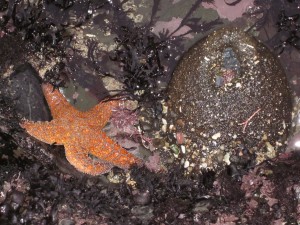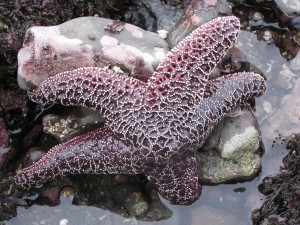Ochre sea stars (Pisaster ochraceus) are a common sight at FMR, but they are always a hit with visitors, perhaps because of their beautiful colors. Usually about as big across as a dessert plate, ochre stars have five arms or rays and come in two color variations at FMR: purple and orange. They cling to rocks and other hard surfaces with thousands of sucker-like tube feet that line their undersides.
The tube feet are interconnected in a sort of hydraulic system and the sea star uses them to “walk” along the sea floor, climb up walls, and hang upside down on overhanging ledges. The tube feet are strong enough to keep the sea star secure against being swept out to sea by pounding waves or flipped over by hungry birds wanting to eat its soft underparts.
The ochre star also eats with its tube feet! The star wraps a couple of its arms around a bivalve such as a California mussel, clamps onto it with its tube feet, and pries open the two shells. Then the star sticks its stomach down into the mussel and dissolves and absorbs the flesh of the mollusk. This can take a while, and you may find an ochre sea star humped up over a prey item while tidepooling. When it has consumed its meal, it pulls its stomach back into its body and moves on.


